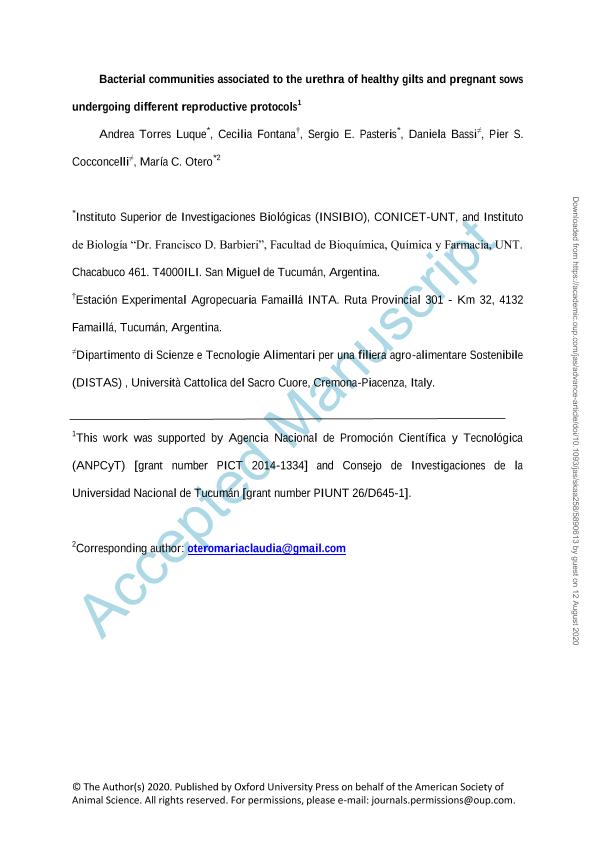Artículo
Bacterial communities associated to the urethra of healthy gilts and pregnant sows undergoing different reproductive protocols
Torres Luque, Andrea ; Fontana, Cecilia Alejandra
; Fontana, Cecilia Alejandra ; Pasteris, Sergio Enrique
; Pasteris, Sergio Enrique ; Bassi, Daniela; Cocconcelli, Pier S.; Otero, María Claudia
; Bassi, Daniela; Cocconcelli, Pier S.; Otero, María Claudia
 ; Fontana, Cecilia Alejandra
; Fontana, Cecilia Alejandra ; Pasteris, Sergio Enrique
; Pasteris, Sergio Enrique ; Bassi, Daniela; Cocconcelli, Pier S.; Otero, María Claudia
; Bassi, Daniela; Cocconcelli, Pier S.; Otero, María Claudia
Fecha de publicación:
09/2020
Editorial:
American Society of Animal Science
Revista:
Journal of Animal Science
ISSN:
0021-8812
e-ISSN:
1525-3163
Idioma:
Inglés
Tipo de recurso:
Artículo publicado
Clasificación temática:
Resumen
Nowadays, it is known that the urogenital microbiota plays a key role in the urinary health of mammalians. Despite the urinary infections affect the health and the welfare of breeding sows, the urethral microbiota of healthy sows remains unknown. Therefore, this work evaluates the urethral bacterial communities of healthy gilts and sows to determine the presence of Enterobacteriaceae populations, and the structure of this microbiota in gilts (G) and pregnant (P) sows. Samples were collected by scraping the urethral mucosa of G (n = 9) and P sows, which included natural mating (NM, n = 9) and artificial inseminated (AI, n = 7) sows. Samples were analyzed by culture-dependent techniques and 16S-rRNA gene high-throughputsequencing. All females were positive for Enterobacteriaceae culture, without significant differences (Kruskal-Wallis) between G and P groups (median values: 2.78 and 3.09 log CFU/mL, respectively; P = 0.497). Also, the rate of Enterobacteriaceae/total mesophilic microorganisms was individually calculated, without significant differences between G and P sows (median values: 0.61 and 0.66, respectively; P = 0.497). When analyzing the bacterial communities, it was found similar richness in G, NM, and AI; however, diversity was lower in P sows than G (Mann Whitney/Kruskal-Wallis test, P < 0.01). The dominating phyla that constituted a "core microbiome"included Firmicutes, Proteobacteria, Cyanobacteria, Actinobacteria, and Bacteroidetes, which were common for all the studied females. The relative abundance for phyla, families, and genera was estimated, and Firmicutes was significantly higher in NM than AI sows (P = 0.02, Mann-Whitney/Kruskal Wallis test for univariate statistical comparisons); Pseudomonadaceae and Enterobacteriaceae were higher in AI than in NM (Mann-Whitney/Kruskal-Wallis, P < 0.05). Lactobacillus and Pseudomonas were among the dominant genera; however, only Pseudomonas sp. was significantly higher in AI than NM (Mann-Whitney/Kruskal-Wallis, P = 0.006). The results represent the first evidence about the existence of a urethral microbiota that includes Enterobacteriaceae, as well as the patterns of this microbiota in G and P sows. The knowledge of this urethral microbiota might allow for future research to develop innovative protocols to restore and/or preserve the healthy ecology of the urinary microbiome to prevent diseases ensuring the welfare of breeding sows.
Palabras clave:
GILTS
,
NEXT GENERATION SEQUENCING
,
PREGNANT SOWS
,
URETHRAL MICROBIOTA
Archivos asociados
Licencia
Identificadores
Colecciones
Articulos(INBIOFAL)
Articulos de INSTITUTO DE BIOTECNOLOGÍA FARMACEUTICA Y ALIMENTARIA
Articulos de INSTITUTO DE BIOTECNOLOGÍA FARMACEUTICA Y ALIMENTARIA
Articulos(INSIBIO)
Articulos de INST.SUP.DE INVEST.BIOLOGICAS
Articulos de INST.SUP.DE INVEST.BIOLOGICAS
Citación
Torres Luque, Andrea; Fontana, Cecilia Alejandra; Pasteris, Sergio Enrique; Bassi, Daniela; Cocconcelli, Pier S.; et al.; Bacterial communities associated to the urethra of healthy gilts and pregnant sows undergoing different reproductive protocols; American Society of Animal Science; Journal of Animal Science; 98; 9; 9-2020; 1-11
Compartir
Altmétricas



